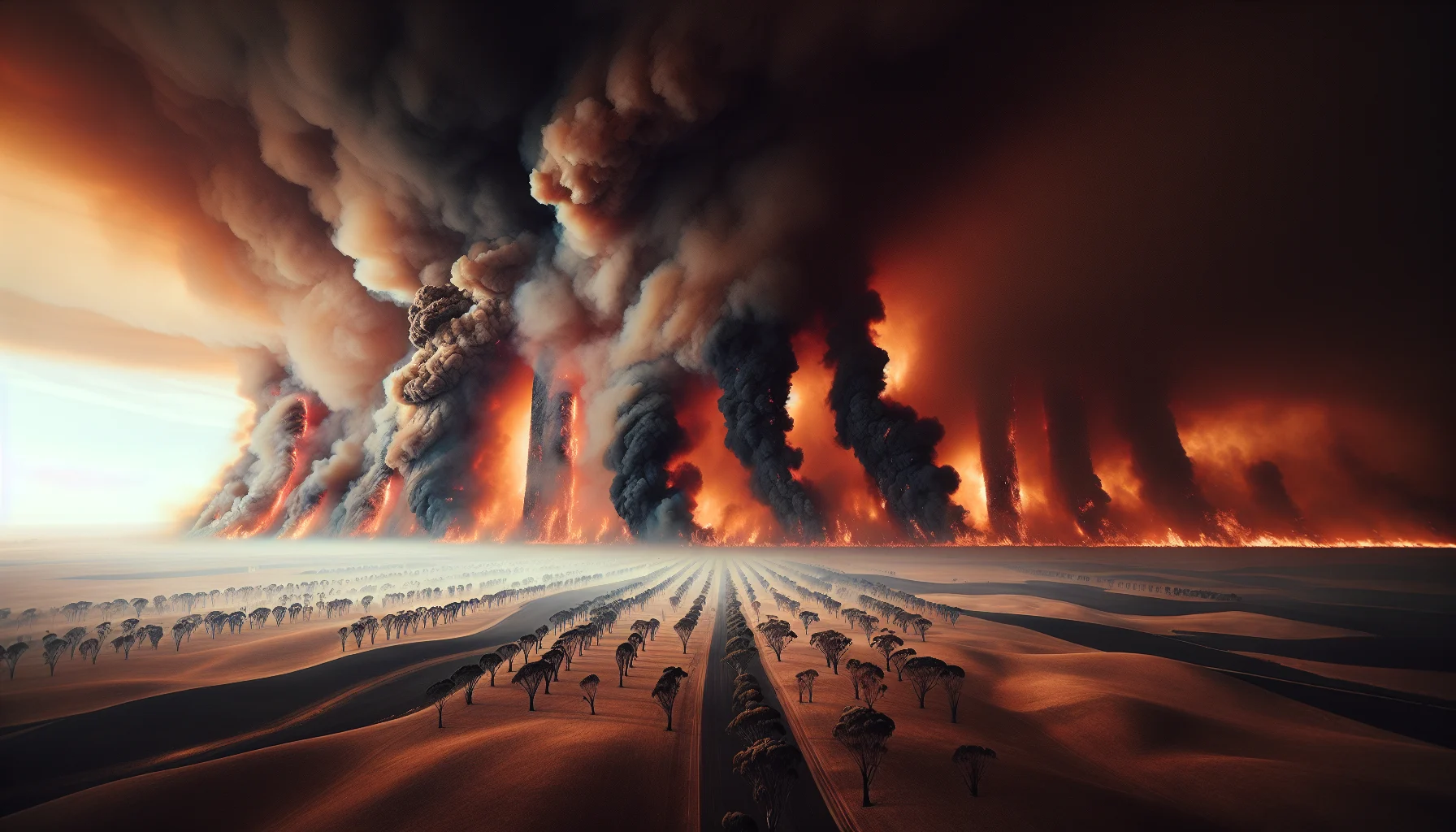
Black Saturday Bushfires
by: The Calamity Calendar Team
February 7, 2009
Australia on Fire: A Nation Tested
On February 7, 2009, a day etched into the annals of Australia's history as "Black Saturday," Victoria was ravaged by devastating bushfires. These fires were not merely a natural disaster but a perfect storm of climatic extremes colliding, pushing a region and its people to the brink. The world watched, aghast, as the fires painted the Australian landscape in hues of orange and black.
The Heatwave: A Looming Threat
As the summer of 2009 intensified, Southeastern Australia entered a harsh heatwave. The region was no stranger to high temperatures and drought, having endured the “Millennium Drought” since the late 1990s. However, the conditions leading up to Black Saturday were unprecedented. A tapestry of factors had woven together over the preceding weeks: record-breaking heat, with temperatures soaring above 46°C (115°F) and bone-dry air, combined with chaotic winds gusting over 100 km/h (62 mph). Victoria became a tinderbox, waiting for a spark.
Melbourne, the bustling capital of Victoria, recorded a sweltering 46.4°C (115.5°F) on the day the fires ignited. As the mercury climbed, the northwesterly winds roared across the landscape, dragging with them the promise of devastation. Emergency services and residents alike were on high alert, anxiously tracking the relentless wave of heat. Despite these warnings, the sheer speed of what was to come caught everyone off guard.
February 7, 2009: Inferno Unleashed
By late morning on February 7, a cascade of fires erupted across Victoria. Among them, the Kilmore East fire—starting at 11:49 AM—would wreak the greatest havoc. Aided by the insatiable winds, flames galloped across the countryside, leaving communities engulfed almost as soon as the fires began. In towns such as Kinglake, Marysville, and Strathewen, the infernos were apocalyptic, as residents found themselves with barely any time to escape.
The chaos spanned several areas as key fires, including the Murrindindi, Beechworth, and Churchill–Jeeralang fires, fanned out over vast distances. Thousands of Victoria’s inhabitants battled nature’s fury, many trapped with limited evacuation routes. The air was thick with smoke and panic; communication failures silenced cries for help.
In the Heart of the Flames
The towns stricken by the Kilmore East and Kinglake fires suffered some of the gravest losses. Whole communities vanished in the blink of an eye. Escape routes were rapidly enveloped by advancing fire fronts, leaving residents stranded in their homes or cars. For many, survival meant seeking refuge wherever possible—cellars, water tanks, or fire bunkers—praying the flames would pass without claiming more lives.
Thanks for subscribing!
Power outages and jammed communications undermined emergency operations, leaving a populace isolated, both physically and informationally. The fire's ability to jump and spread made prediction near-impossible and response efforts frustratingly sluggish.
The Aftermath: Counting the Cost
When dawn broke after the calamitous day, Victoria stood charred and shattered. The human toll was staggering: 173 souls lost, each with a story of anguish and heroism, and more than 400 individuals bearing the scars of burns and injuries. Displacement was widespread, with over 7,562 people—families, children, the elderly—left homeless, standing amidst the smoldering remnants of what was once home.
Beyond the human tragedy, the environment bore its own scars. Over 450,000 hectares (1.1 million acres) of land lay in ashes, habitats destroyed, and wildlife populations decimated. The direct economic cost was measured by the loss of more than 2,000 homes and damage estimates breaching 4.4 billion Australian dollars, yet the true cost was unquantifiable—written in the heartache and loss etched onto the land and its people.
Lessons and Legacy
In the wake of Black Saturday, Australia grappled with profound reflections on climate resilience and disaster preparedness. The Victorian Bushfires Royal Commission set out to investigate what went wrong and how to better equip the nation for future ferondhibition of attire and unheralded exposure to elements in firefighting.
Recommendations burgeoned from the inquiry: enhancing early warning systems, better community education on bushfire safety, and implementing stricter building codes in fire-prone areas. The catastrophic events fueled global conversations about fire management, as Australia became both a cautionary tale and a pioneer in developing robust emergency response frameworks.
Efforts to rebuild were monumental—not only reinstating homes and infrastructure but also rejuvenating ecosystems stripped bare by relentless flames. Restoring the environment and wildlife became a mission met with both sorrow and hope.
A Changing Climate's Impact
The Black Saturday Bushfires are a grim reminder of the challenges posed by a changing climate. They underscore the need for continuous innovation in understanding and mitigating fire behavior. Enhancements in predictive models now aid in foreseeing fire pathologies; however, the narrative of Black Saturday insists on vigilance.
As Australia moves forward, lessons from this calamitous event drive improvements in how we communicate during crises and prepare communities for what once seemed unimaginable. The story of Black Saturday is far from forgotten; it is a constant call to action to nurture resilience against nature’s formidable extremes.
The brutal beauty of the Australian landscape, marked by towering eucalyptus trees and rugged terrain, remains indelibly associated with disaster. Yet, in its regenerative cycle, it also tells a story of recovery, insisting that from devastation we can learn, rebuild, and ultimately persevere.
It is a story not just of bushfires, but of humanity—our fragility, our resilience, and our hope to better understand and overcome the challenges we face as stewards of our planet.
Stay in the Loop!
Become a Calamity Insider and get exclusive Calamity Calendar updates delivered straight to your inbox.
Thanks! You're now subscribed.